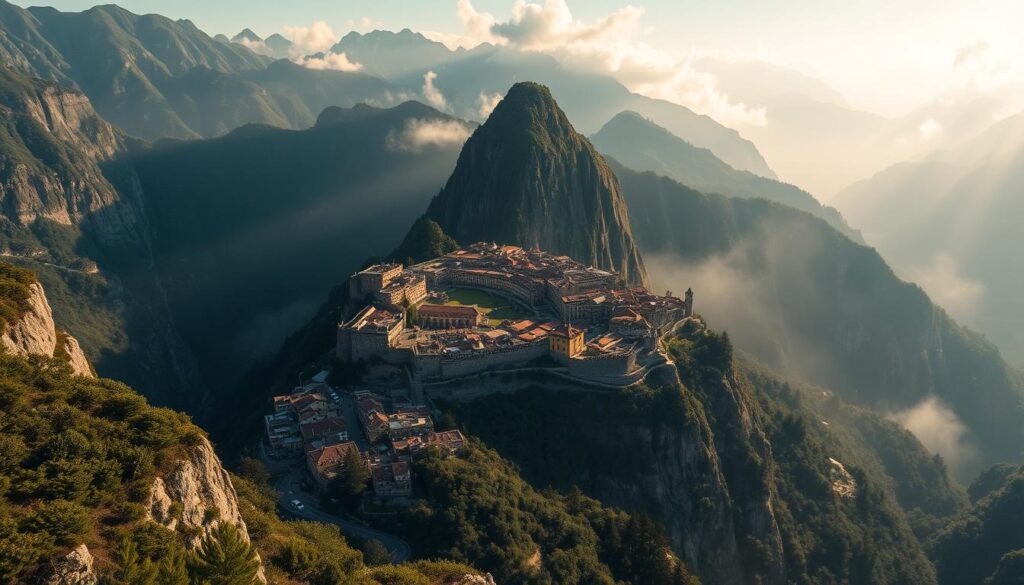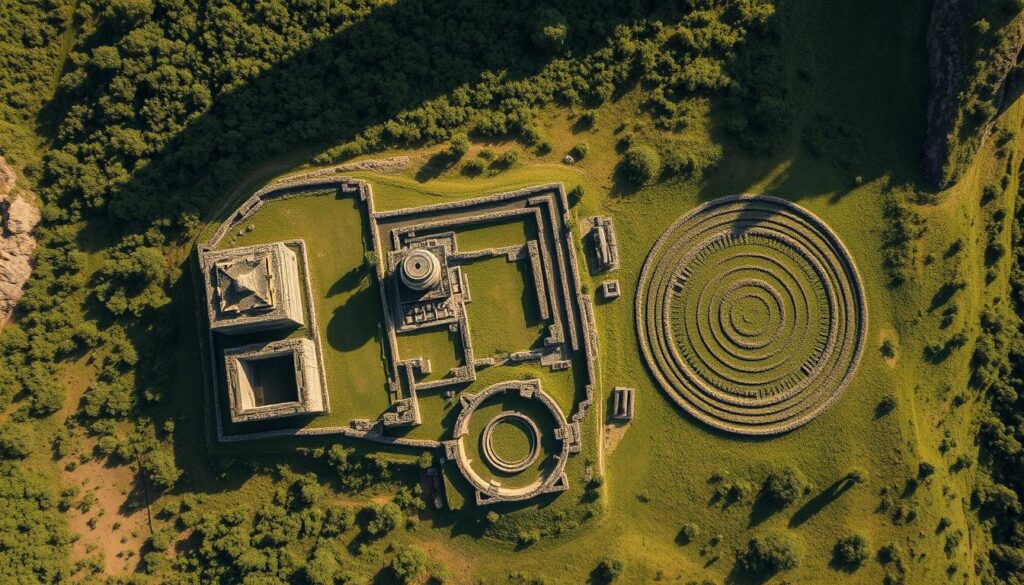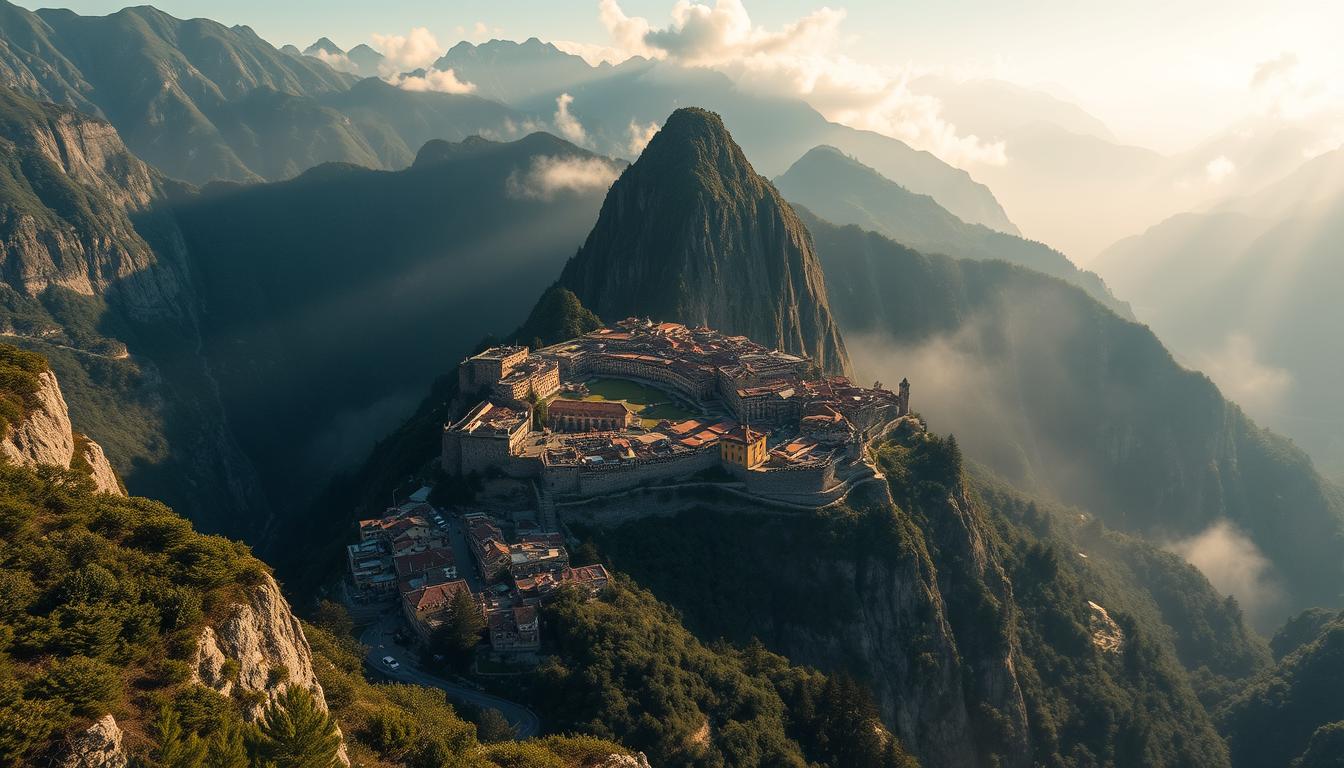High above Earth, a secret waits to be found. A hidden city, full of ancient structures, is invisible to those on the ground. It’s only from the sky that these landmarks show their true beauty, a mystery for years.

Imagine looking at empty plains, unaware of a hidden city above. This find changes our view of ancient civilizations. How did they hide such big structures? Why were they made to disappear at ground level? These questions lead us to uncover one of history’s biggest secrets.
Key Takeaways Hidden City
- The city’s design makes it a unique sky-visible landmark unseen from the ground.
- Hidden ancient structures challenge modern understanding of early engineering.
- Aerial views expose patterns meant to be noticed only from high altitudes.
- Its existence suggests advanced knowledge of geography and optics.
- Discovery highlights gaps in traditional archaeological methods.
Discovering The Hidden City That Can Only Be Seen from the Sky
In 2019, an aerial archaeological discovery amazed everyone. A pilot flying over a remote area spotted strange patterns on the ground. These weren’t natural; they were the remains of a hidden city discovery hidden for thousands of years, Hidden City.
The Moment of Discovery
Archaeologist Dr. Elena Voss confirmed the find. “We saw structures aligned with stars,” she said. “It felt like solving a millennia-old riddle.” The team used drones to map the site, showing streets and plazas only visible from 1,000 feet up – Hidden City.
What Makes This City Unique
- Designed as a celestial calendar, its squares align with solstices.
- Buildings buried 10 feet underground to avoid detection.
- Patterns only appear after seasonal rains reshape the terrain.
First Aerial Documentation
Early surveys used kite-cameras in the 1930s, but poor resolution hid details. Modern LiDAR scans now show 3D models of temples and aqueducts. “This site rewrites how we think about ancient urban planning,” said Voss. The ancient city from above shows civilizations anticipated viewpoints we once thought impossible.
The Mysterious Origins of the Hidden City
Who built this ancient civilization mystery, and why? Experts are still trying to figure it out. Some think it might be linked to the Ancestral Puebloans, while others believe it’s older than any known society.
Carbon dating shows it was built over 2,000 years ago. But, no tools or artifacts have been found. This makes the archaeological enigma even more puzzling.
- Theories include religious offerings to sky gods
- Astronomical calendars aligned with solstices
- Messages for extraterrestrial beings (though debated)
“This place defies logic. Why build something only birds could see?” – Dr. Elena Vazquez, Lead Archaeologist
There are hints of prehistoric aerial designs that needed a lot of planning. Trenches seem to follow star patterns, and mounds match lunar cycles. Some think it was a spiritual “map to the heavens,” while others believe it was a defensive system.
Without written records, every clue is a puzzle piece waiting to connect. Researchers are now using drones to scan for hidden structures. Each scan brings up more questions.
Did the creators intend it as a legacy? A cosmic artwork? Or something we haven’t thought of yet? The answers could change how we see early human ingenuity and our place in the sky.
Ancient Engineering: How Was This Hidden City Created?
Behind the mystery lies a blend of innovation and precision. The builders used ancient construction methods that seemed to defy gravity and perspective. They created patterns that were invisible from the ground. Their techniques show a deep understanding of geometry and teamwork.
Construction Techniques
Workers used basic tools like wooden stakes and ropes to shape landscapes. They employed several key methods:
- Earthen mounds arranged in geometric grids
- Stone markers aligned to reinforce design consistency
- Excavated trenches to create shadow effects at certain times
Astronomical Alignments
“The city’s layout mirrors Orion’s Belt during the summer solstice,” says Dr. Elena Vargas, an archeoastronomy specialist.
Structures were positioned to track celestial events. Sunlight patterns and shadow shifts marked seasons. This guided agriculture and rituals.
Purpose Behind the Design
Was this an offering to the gods or a map for future generations? Theories suggest:
- Religious offerings to celestial deities
- Navigation aids for airborne observers (mythical or human)
- Environmental adaptations using aerial architecture to control water flow
Every line and angle tells a story of human ambition. These clues invite us to rethink ancient societies’ technical and spiritual priorities.
Why This Hidden City Remains Invisible from Ground Level
Imagine standing next to ancient walls but seeing only hills. The ground-level invisibility of this site is a perfect blend of design and nature. Geography, sight tricks, and time’s touch all play a part in hiding it.
Geographical Factors
- Slopes and curves: Gentle rises in the land act like natural barriers, blocking views of the city’s full layout.
- Scale deception: The city’s massive size overwhelms ground observers, making its patterns look like random terrain.
Optical Illusions
The city’s design is like a puzzle piece hidden in a jigsaw.
“Perspective bends reality here,”
say archaeologists. They note how lines and angles dissolve when viewed from below. Shadows and light play tricks, making walls blend into the horizon.
Nature’s Camouflage
Natural camouflage phenomena complete the disguise. Plants grow in patterns that mirror the city’s layout. Erosion and weathering wear away edges. Seasons change its appearance—snow or foliage can either hide or briefly reveal sections, like a seasonal cloak.
Together, these elements turn the city into a silent guardian of its own secrets. It is visible only when eyes look down from above.
Best Ways to Experience This Aerial Marvel
Discover the hidden city’s beauty with these immersive options. They are perfect for aerial tourism lovers. Each way gives a unique view, from high above to up close.
- Helicopter tours: Many operators offer 30-minute to 1-hour flights. These tours give you close-up views and controlled hovering, great for photography. Prices start at $200 per person.
- Hot air balloon rides: Enjoy a calm drift at sunrise or sunset. Skybound Adventures offers packages with flights and guided tours.
- Drone photography experiences: Licensed operators lead groups in capturing footage. Drone rentals need permits; check local rules before flying alone.
A comparison of options:
| Method | Best For | Cost | Season |
|---|---|---|---|
| Helicopter tours | Photography and speed | $200–$400 | Year-round |
| Hot air balloon | Romantic views | $150–$250 | Spring/Fall |
| Drone photography | DIY enthusiasts | $50–$150 | Clear skies |
Can’t visit in person? Try virtual reality platforms like SkyTour for 360° tours. Visitor centers near the site offer 4K videos and interactive maps to learn more.
“The city’s patterns only reveal themselves when you’re airborne—it’s a revelation,” says Maria Chen, a certified aerial guide.
Plan ahead: Book tours 2–3 months in advance. Choose clear weather months (March–May, September–November) for the best views. Always check drone permissions and weather before your trip.
The Cultural Significance of the Sky-Visible City
Buried beneath the earth, the city’s ancient aerial symbols tell tales older than any book. Its discovery has started talks about cultural heritage significance. It shows how past and present are connected.

“The lines were drawn by the sky spirits to guide our ancestors,” a local elder once shared, reflecting archaeological folklore that has shaped regional identity for centuries.
Local Legends and Folklore
Stories from nearby communities say the site is a celestial map or a sacred gameboard. These tales, passed down, often connect the patterns to seasons or myths. Now, archaeologists look at these stories as keys to the city’s true purpose.
Impact on Understanding Ancient Civilizations
- Reveals advanced knowledge of geometry and astronomy.
- Challenges assumptions about early societies’ technical skills.
- Highlights shared human curiosity about the cosmos.
Modern Cultural References
Today, the site inspires art and new theories. Books like Signs in the Sky explore its possible links to lost technologies. Conspiracy forums debate its origins, mixing fact with fiction. Yet, its cultural heritage significance connects science and storytelling.
Preservation Challenges and Conservation Efforts
Keeping the hidden city safe requires special archaeological site preservation plans. Wind and changing weather can harm its old surfaces. People walking by or nearby building projects also pose risks. Teams work hard to keep it safe for everyone.
- Climate adaptation: Sand barriers and moisture controls shield against weathering.
- Visitor management: Restricted access zones limit physical damage.
- Community partnerships: Local stewards share traditional knowledge to guide repairs.
“Every grain of sand here tells a story. We’re using drones and 3D scans to monitor changes without disturbing the site.” — Dr. Elena Marquez, UNESCO field researcher
Protecting the site is a global effort. UNESCO started a 2023 program to watch over it from space. They use laser scans to keep a digital record of the city’s shape. This way, even if it changes, we can still see its beauty.
Visitors can make a difference by choosing tours that help save the site. Just by staying on the path, you help protect it. Plans are underway to use AI to predict and prevent damage. With technology and community help, this amazing city will be here for many years.
Similar Hidden Wonders Around the World
Earth’s surface is full of secrets that only show up from above. From the Nazca Lines in Peru to desert carvings in Kazakhstan, these ancient designs are a global network of global geoglyphs. They make us think about why ancient cultures made designs for the sky.

Nazca Lines of Peru
The Nazca Lines cover 50 miles of coastal desert in Peru. They show animals like monkeys and spiders. Like our hidden city, they were made with stones and erosion control.
While Nazca’s art shows animals, our hidden city has grid patterns. These patterns might be for function or ceremonies. Both are threatened by climate and human actions.
Ancient Desert Geoglyphs
Geoglyphs are found all over the world. They are huge and made for the sky:
- Atacama Giant, Chile: A 3D clay structure guiding rituals in the driest desert
- Blythe Intaglios, USA: Human figures carved into California’s Colorado Desert
- Steppe Geoglyphs, Kazakhstan: Swirling patterns found via satellite, older than Nazca
Modern Aerial Discoveries
New tech finds aerial archaeological sites every year. LiDAR showed Angkor’s full layout in Cambodia. Drones found Roman roads in Britain. These finds show we’re still exploring—more secrets are waiting in the skies and landscapes.
If you were amazed by The Stunning Hidden City That Can Only Be Seen from Above or excited to Embark on an Endless Road of Discovery, then get ready for another breathtaking adventure! Check it out now!
Conclusion: The Enduring Mystery Above Our Heads
The story of the hidden city is a mix of science and wonder. It’s one of the world’s most fascinating unsolved archaeological mysteries. Its ancient aerial artwork makes us question how early societies saw their world.
Today, we use drones and satellites to uncover more. But, many questions still remain. Who built it? And why did they design it to be seen only from the sky?
This mystery is a top historical sky puzzle. The reasons behind its creation are still unknown. Scholars debate whether it honored the cosmos, communicated with the divine, or mapped time.
With new technology, we might solve these mysteries. Archaeologists and astronomers work together. They use data to explore celestial connections. Each new find opens up more questions and curiosity.
Is there more ancient aerial artwork waiting to be found? As we use drones to scan the earth, we might discover something new. The sky still holds secrets, encouraging us to look up and wonder.
FAQ
What is the hidden city, and how was it discovered?
The hidden city is a remarkable archaeological site best seen from above. It was probably found during an aerial survey. A pilot or researcher noticed patterns from the sky.
This discovery has excited both archaeologists and the public.
Why was the city designed to be seen only from the sky?
It’s thought the city’s design was for social, religious, or ceremonial reasons. The aerial patterns might have communicated with gods. Or they could have aligned with celestial events.
How do archaeologists date the hidden city?
Archaeologists use carbon dating, artifact analysis, and historical findings to date the site. This method gives insights into the site’s age and the civilizations that built it.
What are the main challenges in preserving the hidden city?
The site faces threats from erosion, tourism, and vandalism. Preservation efforts include advanced mapping and working with local communities. This ensures the site is safe for future generations.
Are there ways to experience the hidden city without flying?
Yes! You can explore the site virtually through 3D models and high-resolution photos online. Local museums or visitor centers also offer exhibits about the site.
What similar sites exist around the world?
Sites like the Nazca Lines in Peru and desert geoglyphs worldwide are similar. They show patterns meant for aerial viewing. These designs highlight a global tradition of monumental designs.
What is the significance of local legends relating to the hidden city?
Local legends offer interesting stories about the city’s origins and purpose. These tales reflect the cultural heritage and values of indigenous communities. They give insight into how people connected with the land over time.
Can anyone fly over the hidden city for a tour?
Access to aerial tours depends on local regulations. Check with tour companies about allowed activities and drone use before visiting.
How do modern technologies contribute to discovering similar hidden sites?
New technologies like satellite imaging, LiDAR, and drone surveys are changing archaeology. They help uncover sites hidden by vegetation. These tools reveal patterns invisible from the ground.
